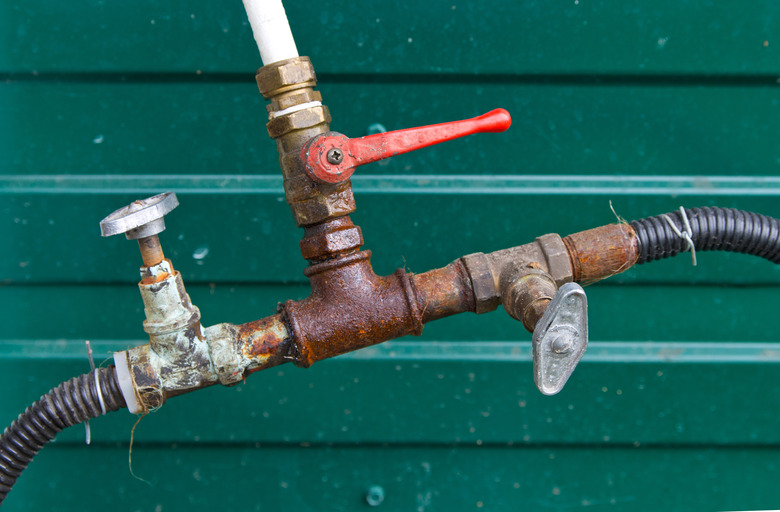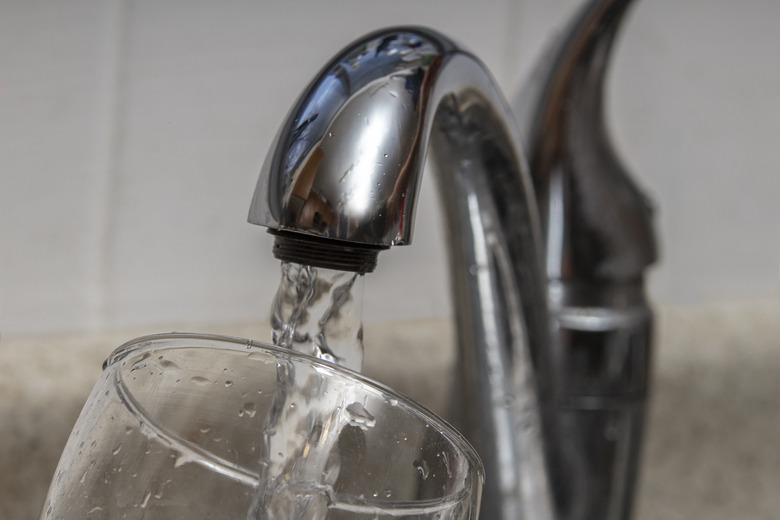The 8 Most Common Sources Of Lead In Your Home
We may receive a commission on purchases made from links.
Lead is an environmental toxin, and although its use in paints, water pipes and gasoline has been banned, there are still many possible sources of lead exposure around the average home. This is due partly to an aging infrastructure that still relies on lead water pipes and partly to residue left over from an era when lead was unregulated. That era wasn't very long ago; the federal government finally banned the use of lead in paint, which was one of the most common ways for lead to enter the home, as recently as 1978.
Lead poisoning can affect everyone, but young children are particularly vulnerable and can suffer learning disabilities as well as neurological and physiological diseases. The human body has no way of processing lead, and because it doesn't form compounds that allow it to be digested and eliminated, it basically remains in the body forever, collecting in organs such as the kidneys, stomach and brain and becoming more and more harmful as it accumulates. Pregnant women can pass lead to their unborn children, although they may be able to reduce blood lead levels by increasing their intake of calcium and iron.
Because of the likelihood of the presence of lead paint, people living in older homes built before 1978 are at higher risk of lead exposure than those living in recently built homes, but there are many other sources of lead that are common to all homes. If you want to protect yourself and your family, it's important to know where to look.
1. Paint: One of the Most Common Sources of Lead
1. Paint: One of the Most Common Sources of Lead
Any house built before 1978 has a 24 percent chance of having lead-painted walls or woodwork, and the likelihood goes up to 69 percent for houses built between 1940 and 1959 and to 87 percent for houses built before 1940. The lead paint may be buried under several coats of nonlead paint, but that doesn't necessarily make it safer because lead can still leach to the surface, where a curious toddler can ingest it. The lead paint can also be exposed when old paint begins chipping or flaking off or when windows and doors rub through layers of paint from being opened and closed, often creating dust containing lead.
It's advisable for homeowners to test painted surfaces for lead using store-bought kits. The Environmental Protection Agency (EPA) recommends two products: D-Lead and 3M LeadCheck, but other products can also reliably identify lead. No amount of lead is safe for young children, and the health effects can be catastrophic, so a positive test should be followed by a remediation strategy.
2. Most Lead Exposure Comes From Dust
2. Most Lead Exposure Comes From Dust
Lead from painted surfaces usually finds its way into people's bodies by becoming airborne, where it can be inhaled as household dust. This can happen when paint chips off surfaces and falls to the floor to be ground underfoot, and it can happen indoors or outdoors. Besides floating in the air, lead dust can also settle on children's toys or other items they are likely to put in their mouths. Because it's often invisible, lead dust is difficult to detect, and the best way to control it is to deal with the main source, which is old, flaking lead paint on interior and exterior surfaces.
Air pollution containing lead may originate in places other than the home itself. It could be near industrial facilities, such as smelters, waste incinerators or factories that make use of lead. Contact your local environmental health authority if you suspect a nearby facility is releasing lead into the air.
3. Lead in Drinking Water
3. Lead in Drinking Water
Lead doesn't occur naturally in groundwater and most often gets into drinking water because of corrosion of lead-based water pipes, of which some 6 million are still in use around the country. Lead can also leach into drinking water from lead solder used to join copper pipes and old brass faucets that may contain lead. You can use a store-bought kit to test for lead in drinking water. If the test is positive, you can't change the pipes, but you can reduce lead exposure by boiling cold water instead of using hot water from the faucet. Hot water is more likely to contain dissolved lead.
4. Lead Accumulates in the Soil
4. Lead Accumulates in the Soil
Lead dust resulting from chipping or flaking paint can settle in the soil around a house painted with lead paint, but that isn't the only way lead gets into the soil. You may find high levels of lead in bare soil adjoining busy roadways left over from emissions from automobiles burning leaded gasoline. Even though lead additives were banned by the Clean Air Act of 1996, the lead still remains along with lead produced by industrial processes that use the lead compounds, such as smelting.
You can test the soil with a store-bought kit, and if it shows elevated levels of lead, consider planting sunflowers, ragweed, corn, rapeseed or ornamental cabbage, which are all crops that can leach lead from the soil. Do not consume any products derived from plants grown in soil with a high lead level.
5. Some Foods and Medicines Contain Lead
5. Some Foods and Medicines Contain Lead
A number of folk remedies from various parts of the world contain lead or are themselves lead compounds. For example, azarcon and greta, which are traditional Hispanic remedies for upset stomach, can have lead content as high as 90 percent, according to the Centers for Disease Control and Prevention. Other folk remedies that may contain lead include Daw Tway (Thailand), Ba-baw-san (China) and Ghasard (India) as well as other Ayurvedic remedies from India and Southeast Asia.
Some imported spices and candies may also contain lead, including tamarind and chili powder from Mexico, turmeric from India and other spices originating in Georgia, Pakistan, Nepal, Bangladesh, India or Morocco. Certain cosmetics may also contain lead compounds for coloration, particularly sindhoor, the red powder used traditionally in Hindu and Sikh cultures.
6. Food Containers May Be Sources of Lead
6. Food Containers May Be Sources of Lead
Ceramic pottery and other containers imported from certain countries may be glazed with lead compounds, and the lead can leach into food stored in these containers. You can usually recognize these containers because they are heavy, brightly colored and obviously handmade. Tin cans from certain parts of the world may be manufactured with lead solder, and they are also possible sources of lead exposure. These cans usually have noticeably wide seams with a dull coloration.
7. Some Children's Toys Contain Lead
7. Some Children's Toys Contain Lead
Lead can be used to soften plastic, and lead may also be present as an alloy with another metal, such as tin to make metal toys. When left to degrade in the sun, toys containing lead may develop a dusty coating that children can ingest. Some brightly painted children's toys may also have a coat of lead-based paint. Old and antique toys are most suspect as well as toys originating in parts of the world where lead regulations are lax. You can't reliably test toys for lead, so if you suspect a particular toy contains lead, the best course of action is to discard it.
8. Blinds and Stained Glass May Contain Lead
8. Blinds and Stained Glass May Contain Lead
Lead can turn up in unexpected places. For example, some nonglossy vinyl miniblinds may be sources of lead exposure. Certain hobby supplies can expose you to lead, particularly stained glass solder, which often contains lead. People who engage in hobbies such as making their own stained glass or fishing tackle outside the home may track lead dust back home on their shoes or clothing.
References
- New York State Department of Health: Sources of Lead
- Centers for Disease Control and Prevention: Childhood Lead Poisoning Prevention: Pregnant Women
- A Magical Life: Seven Plants, Weeds and Flowers That Naturally Remove Lead from Your Property
- Centers for Disease Control and Prevention: Lead in Foods, Cosmetics, and Medicines
- U.S. Environmental Protection Agency: Protect Your Family from Sources of Lead


